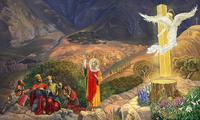Georgia, a country rich in history and culture, has a religious landscape that is as diverse as its topography. This article delves into the historical evolution of pre-Christian religions in Georgia, exploring the intricate tapestry of beliefs and practices that predate the advent of Christianity in this region. The focus is strictly on the historical and factual aspects of these ancient religions, tracing their development and influence on Georgian culture.
Pre-Christian Religions in Ancient Georgia
Before Christianity was established in Georgia in the 4th century AD, a myriad of pre-Christian religions thrived. The primary belief systems included paganism, which was predominantly polytheistic, and Zoroastrianism, which had a significant influence due to Persian invasions.
Paganism in Georgia was characterized by the worship of numerous gods and goddesses, mirroring the natural and social environments. Chief among these deities were gods of the sun, moon, and various natural phenomena. Archaeological findings, such as statues, inscriptions, and temples, provide evidence of this rich polytheistic culture. The supreme god in the Georgian pantheon was known as "Ghmerti," often associated with the Greek Zeus or the Roman Jupiter, indicating possible influences from neighboring civilizations.
Zoroastrianism, on the other hand, found its way into Georgia through the Persian influence, particularly during the Achaemenid and Sassanian empires. This monotheistic religion, founded by the prophet Zoroaster in ancient Iran, introduced concepts of dualism, with the ongoing battle between good (Ahura Mazda) and evil (Angra Mainyu). Its impact on Georgian culture was significant, contributing to the religious and philosophical discourse of the time.
Archaeological Discoveries and Their Significance
Georgia's landscape is dotted with archaeological sites that offer insights into its pre-Christian era. Vani, a site in western Georgia, has yielded numerous artifacts, including gold and silver jewelry, bronze figurines, and pottery, all pointing towards a sophisticated culture with extensive trade links. These artifacts suggest that the ancient Georgians engaged in rituals and had a highly developed artistic sense.
Another notable site is Mtskheta, the ancient capital of Georgia. Here, excavations have revealed structures and artifacts that attest to the religious practices before Christianity. The findings include temples and sacrificial altars, indicating a complex ritualistic practice centered around offerings to the gods.
Influence of Ancient Greek and Roman Religions
The impact of Ancient Greek and Roman religions on pre-Christian Georgian beliefs cannot be overstated. Through trade and cultural exchanges, elements of Greek and Roman pantheons were integrated into the local religious practices. This syncretism is evident in the adaptation of Greek gods into the Georgian pantheon and the introduction of new religious practices and iconography.
For instance, the worship of the Greek goddess Aphrodite and the god Dionysus found its way into Georgian religious practice. Temples dedicated to these deities have been unearthed, suggesting that their worship was widespread. This cultural exchange illustrates the dynamic nature of ancient Georgian religious beliefs and practices, which were open to external influences while retaining their unique characteristics.
The Role of Mythology in Pre-Christian Georgia
Mythology played a vital role in the religious life of pre-Christian Georgia. Myths, legends, and folk tales served not just as entertainment, but as a means to explain natural phenomena, social structures, and moral codes. These stories were often centered around heroes, gods, and mythical creatures, and were integral to the religious and cultural education of the Georgian people.
The Georgian myths often reflected the values and beliefs of their society, emphasizing virtues such as bravery, honor, and respect for nature. These stories were passed down orally through generations and continue to be a significant part of Georgia's cultural heritage.
Transition to Christianity and Its Impact
The conversion of Georgia to Christianity in the early 4th century marked a significant turning point in the religious history of the country. Saint Nino is credited with the Christianization of Georgia, leading to the gradual decline of pre-Christian religions. However, the transition was not abrupt; many pre-Christian beliefs and practices were integrated into the newly established Christian traditions.
This syncretism is evident in various Christian festivals and rituals, which bear traces of pagan customs. For instance, certain Christian saints replaced the roles of old deities, and pagan symbols were reinterpreted within a Christian context.
Tourism and the Legacy of Pre-Christian Religions
Today, Georgia’s rich religious history attracts tourists and scholars from around the world. The ancient sites, such as Vani and Mtskheta, offer a glimpse into the pre-Christian era and are significant attractions for those interested in religious and historical tourism. Guided tours often focus on exploring these ancient ruins, providing insights into the religious practices and beliefs of the time.
Conclusion
The historical evolution of pre-Christian religions in Georgia presents a fascinating journey through time, showcasing a complex interplay of indigenous beliefs and external influences. From paganism to Zoroastrianism, and the subsequent integration of these beliefs into Christianity, Georgia’s religious history is a testament to its cultural richness and diversity. For travelers and history enthusiasts, exploring this aspect of Georgia offers a deeper understanding of the country’s heritage and its enduring legacy.

 Conversion to Christianity in Georgia
Conversion to Christianity in Georgia
 Soviet-era Atheism
Soviet-era Atheism
 Post-Soviet Religious Revival in Georgia
Post-Soviet Religious Revival in Georgia




